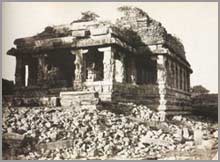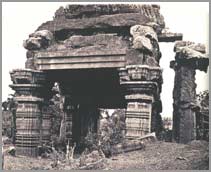Visual Evidence
 Fergusson’s aim of creating visual documents that could transcribe his vision was not novel, as the painters, William and Thomas Daniells, had harboured similar objectives before him. But the distinction he made between his sketches and theirs is instructive to note. For, it has a resonance on what was subsequently, i.e. during the twentieth century, promoted as ‘valid’ depictions of archaeological work. Fergusson saw the defects in the Daniells’ work not due to “the want of correct rendering”, but because of “an avowed attempt to make pleasing artistic compositions out of the sketches before they were delivered into the hands of the engravers”. Therefore, although he considered their drawings “infinitely more valuable” than his as works of art, he was also of the opinion that it is the “aesthetic value which entirely destroys its value as one of information or instruction” (ibid).
Fergusson’s aim of creating visual documents that could transcribe his vision was not novel, as the painters, William and Thomas Daniells, had harboured similar objectives before him. But the distinction he made between his sketches and theirs is instructive to note. For, it has a resonance on what was subsequently, i.e. during the twentieth century, promoted as ‘valid’ depictions of archaeological work. Fergusson saw the defects in the Daniells’ work not due to “the want of correct rendering”, but because of “an avowed attempt to make pleasing artistic compositions out of the sketches before they were delivered into the hands of the engravers”. Therefore, although he considered their drawings “infinitely more valuable” than his as works of art, he was also of the opinion that it is the “aesthetic value which entirely destroys its value as one of information or instruction” (ibid).
 The use of photography during the nineteenth century to document India’s architectural heritage is rather well known. The first official steps to list the ‘historically important’ monuments is the Despatch of 1847, through which the Governor-General, Lord Hardinge, received instructions from London to draw out a preliminary programme that would eventually lead to “The Great Objective”, viz., the documentation of monuments through illustrations and photography (see also Falconer 2001, p. 15). Eventually, acting on the proposal, the Bombay Presidency through the initiatives of the Bombay branch of the Asiatic Society, financed what can be regarded as a pilot scheme, and commissioned, in succession, two photographers, Major Biggs, of the Bombay artillery (Figure 7), and William Pigou of the Bombay Medical Service, between 1855 and 1857. The Madras Presidency employed Linnaeus Tripe, the official photographer of the British Mission to Ava, as the photographer of the Presidency for two years, from 1856 to 1858 (Figure 8). While the documentary motivations of Biggs, Pigou and Tripe are apparent in their photographs, so are their Victorian morals and politics. Biggs had noted that had he remained in his post longer he would have applied for authority to have the erotic sculptures he encountered within the temples effaced as they were yet “another proof of the early date at which morals of India assumed such a headlong and downward tendency” (quoted in ibid, p. 19). Tripe on the other hand often allowed his photographs to be used for cultivating a positive message of material progress under the British rule, believing that the photographs would show “everything”, which “speak in language that cannot be mistaken, that a brighter day has already dawned in India” (ibid).
The use of photography during the nineteenth century to document India’s architectural heritage is rather well known. The first official steps to list the ‘historically important’ monuments is the Despatch of 1847, through which the Governor-General, Lord Hardinge, received instructions from London to draw out a preliminary programme that would eventually lead to “The Great Objective”, viz., the documentation of monuments through illustrations and photography (see also Falconer 2001, p. 15). Eventually, acting on the proposal, the Bombay Presidency through the initiatives of the Bombay branch of the Asiatic Society, financed what can be regarded as a pilot scheme, and commissioned, in succession, two photographers, Major Biggs, of the Bombay artillery (Figure 7), and William Pigou of the Bombay Medical Service, between 1855 and 1857. The Madras Presidency employed Linnaeus Tripe, the official photographer of the British Mission to Ava, as the photographer of the Presidency for two years, from 1856 to 1858 (Figure 8). While the documentary motivations of Biggs, Pigou and Tripe are apparent in their photographs, so are their Victorian morals and politics. Biggs had noted that had he remained in his post longer he would have applied for authority to have the erotic sculptures he encountered within the temples effaced as they were yet “another proof of the early date at which morals of India assumed such a headlong and downward tendency” (quoted in ibid, p. 19). Tripe on the other hand often allowed his photographs to be used for cultivating a positive message of material progress under the British rule, believing that the photographs would show “everything”, which “speak in language that cannot be mistaken, that a brighter day has already dawned in India” (ibid).
